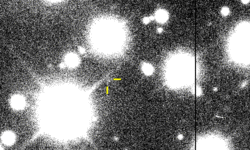Erinome facts for kids

Erinome imaged by the Canada-France-Hawaii Telescope in December 2001
|
|
| Discovery | |
|---|---|
| Discovered by | Scott S. Sheppard David C. Jewitt Yanga R. Fernandez Eugene A. Magnier |
| Discovery site | Mauna Kea Observatory |
| Discovery date | 23 November 2000 |
| Designations | |
| MPC designation | Jupiter XXV |
|
Named after
|
Erinoma (Greek form unknown) |
| S/2000 J 4 | |
| Orbital characteristics | |
| Epoch 17 December 2020 (JD 2459200.5) | |
| Observation arc | 16.34 yr (5,967 days) |
| 0.1494286 AU (22,354,200 km) | |
| Eccentricity | 0.2052559 |
| –682.80 d | |
| 98.99686° | |
|
Mean motion
|
0° 31m 38.062s / day |
| Inclination | 164.81976° (to ecliptic) |
| 34.02660° | |
| 81.11760° | |
| Satellite of | Jupiter |
| Physical characteristics | |
|
Mean diameter
|
3 km |
| Albedo | 0.04 (assumed) |
| 22.8 | |
| 16.0 | |
Erinome, also known as Jupiter XXV, is one of the many small moons that orbit the giant planet Jupiter. It's called an irregular satellite because its orbit is not a perfect circle and it's quite far from Jupiter. Erinome was found in 2000 by a team of astronomers from the University of Hawaii. This team was led by Scott S. Sheppard. When it was first discovered, it was given the temporary name S/2000 J 4.
Erinome is quite small, only about 3 kilometers (about 1.8 miles) across. It travels around Jupiter at an average distance of about 22,986,000 kilometers (about 14.2 million miles). It takes Erinome about 682.80 Earth days to complete one full trip around Jupiter.
Erinome's orbit is also retrograde. This means it moves in the opposite direction compared to Jupiter's rotation and most of its other moons. Its orbit is also tilted quite a bit, about 164 degrees, when compared to the ecliptic (the plane where Earth and most planets orbit the Sun).
The Carme Group
Erinome is part of a group of moons called the Carme group. This group is named after its largest member, Carme. All the moons in the Carme group are irregular and orbit Jupiter in a retrograde (backward) direction.
These moons orbit Jupiter at a distance of about 23 to 24 million kilometers. They also have a similar tilt in their orbits, around 165 degrees. Scientists believe that these moons might have once been a single, larger object that broke apart after a collision.
Naming Erinome
Erinome was officially named in October 2002. It is named after a figure from ancient Greek stories, Erinoma. In these stories, Erinoma was a woman from Cyprus.
The way moons are named follows rules set by the International Astronomical Union (IAU). For moons that orbit backward (retrograde), their names usually end with the letter "-e". This is why "Erinoma" was changed to "Erinome".
See also
 In Spanish: Erínome (satélite) para niños
In Spanish: Erínome (satélite) para niños

